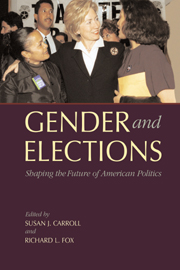Book contents
- Frontmatter
- Contents
- List of Figures, Text Boxes, and Photo
- List of Tables
- Acknowledgments
- List of Contributors
- Introduction: Gender and Electoral Politics into the Twenty-First Century
- 1 Presidential Elections
- 2 Voter Participation and Turnout
- 3 Voting Choices
- 4 Congressional Elections
- 5 African American Women and Electoral Politics
- 6 Political Parties and Women's Organizations
- 7 Advertising, Web Sites, and Media Coverage
- 8 State Elections
- Index
4 - Congressional Elections
Where Are We on the Road to Gender Parity?
Published online by Cambridge University Press: 05 June 2012
- Frontmatter
- Contents
- List of Figures, Text Boxes, and Photo
- List of Tables
- Acknowledgments
- List of Contributors
- Introduction: Gender and Electoral Politics into the Twenty-First Century
- 1 Presidential Elections
- 2 Voter Participation and Turnout
- 3 Voting Choices
- 4 Congressional Elections
- 5 African American Women and Electoral Politics
- 6 Political Parties and Women's Organizations
- 7 Advertising, Web Sites, and Media Coverage
- 8 State Elections
- Index
Summary
Republican House candidate Melissa Brown successfully worked the small crowd at Beauty Worx Day Spa in Philadelphia. After meeting Brown, one beautician declared: “I want to support a woman.” Another followed with: “Girl Power!” Brown quickly cut in, telling the group: “I am actually running against a woman.” Indeed, the 2004 contest in Pennsylvania's 13th congressional district was one of eleven House races nationwide where women squared off against each other. Three of these races were open seats vacated by men, promising at least minor gains in the number of women serving in the House. Melissa Brown, however, was not one of the gains for women. Her opponent, Democratic state senator Allyson Schwartz, ultimately won the race.
Several states away, in Illinois, Democratic challenger Melissa Bean startled the political world by knocking off incumbent Philip Crane, the longest serving Republican member of the House of Representatives. Bean, a businesswoman whose only prior electoral experience was running against and losing to Crane two years earlier, devoted two years to campaigning in the district after her initial loss. She successfully portrayed Crane as lazy and out of touch, labeling him the “junket king” of Congress. Bean was one of only two Democratic challengers in 2004 able to unseat Republican incumbents. University of Chicago public policy professor Christopher Berry called Bean's victory one of the few “bright spots” for Democrats nationally.
- Type
- Chapter
- Information
- Gender and ElectionsShaping the Future of American Politics, pp. 97 - 116Publisher: Cambridge University PressPrint publication year: 2005
- 2
- Cited by



